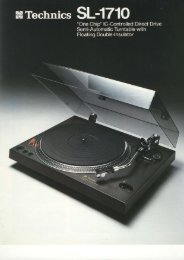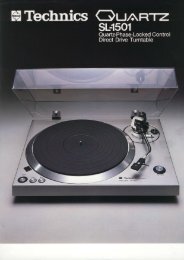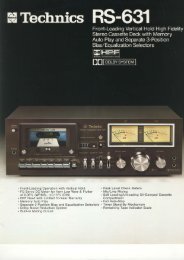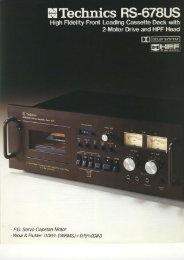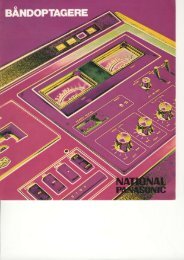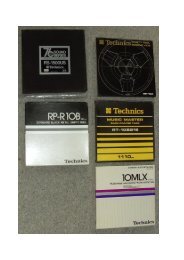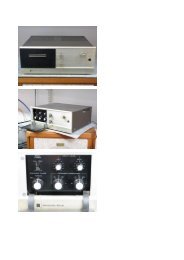When the predecessor of the 34-5560, the prestigious SA-5550, was ...
When the predecessor of the 34-5560, the prestigious SA-5550, was ...
When the predecessor of the 34-5560, the prestigious SA-5550, was ...
You also want an ePaper? Increase the reach of your titles
YUMPU automatically turns print PDFs into web optimized ePapers that Google loves.
<strong>When</strong> <strong>the</strong> <strong>predecessor</strong> <strong>of</strong> <strong>the</strong> <strong>34</strong>-<strong>5560</strong>, <strong>the</strong> <strong>prestigious</strong><strong>SA</strong>-<strong>5550</strong>, <strong>was</strong> introduced, it won widespread praise fromimpartial test laboratories reporting in leading audiomagazines. "ln every respect, a first-rate receiver," ..."more than good enough to satisfy <strong>the</strong> requirements <strong>of</strong>even a critical hi-fi enthusiast," ... "definitely stands outas one <strong>of</strong> <strong>the</strong> more distinguished entries," went some <strong>of</strong><strong>the</strong> comments. The 54-<strong>5560</strong> combines retention <strong>of</strong> <strong>the</strong>finest virtues <strong>of</strong> its forerunner with substantialimprovements in. all areas.The <strong>SA</strong>-<strong>5550</strong> combined substantial power output andlow distortion with superb FM performance, involving"Flat Group Delay" ceramic filters in <strong>the</strong> lF section andsophisticated PLL stereo multiplex circuitry. Even ottneglectedAM perlormance <strong>was</strong> exceptional. Nicetiesincluded click-stop tone controls, multiple protectioncircuitry, two tuning meters and both high- and lowfrequency cut<strong>of</strong>f f i lters.The 3A-<strong>5560</strong> has even greater power output at stilllower distortion. There are improvements in <strong>the</strong> oowersupply and phonograph equalizer and in <strong>the</strong> FM section.An accurately resettable, 41-position click-stop volumecontrol has been added, as well as an FM multiplex highblendswitch, lower-distortion detection and moresophisticated muting. An already superb receiver hasbeen suroassed.
<strong>SA</strong>- <strong>5560</strong>tt/AM stereo FbceirerAmplifier SectlonMassive Power OutputThe 5A-<strong>5560</strong> will selve as <strong>the</strong> powerfulbackbone for any stereo system. ltdelivers 90 watts per channel, minimumRMS. into 4 ohms from 20 Hzto 2O kHz'with no more than 0.1% total harmonic distortion(both channels driven). At '1,000 Hz,this figure rises to 108 watts per channelat 4 ohms.Massive Power SupplyPower-output performance ultimatelydepends on <strong>the</strong> power supply. The ULapproval accorded <strong>the</strong> 5A-<strong>5560</strong> is partialtestimony to <strong>the</strong> generous design <strong>of</strong> itspower supply and more than sufficientomeet <strong>the</strong> demands <strong>of</strong> <strong>the</strong> amplifier. Abridged rectifier circuit helps assureexcellent regulalion <strong>of</strong> DC voltage in <strong>the</strong>face <strong>of</strong> changes in line voltage or signalinput. A 15,000 micr<strong>of</strong>arad filter capacitoris used in ei<strong>the</strong>r side <strong>of</strong> <strong>the</strong> balancedpower supply for <strong>the</strong> unusual total <strong>of</strong>30,000 micr<strong>of</strong>arads capacity. This not onlycontributes to <strong>the</strong> excellent regulation, butalso keeps hum and noise low andimproves power availability at <strong>the</strong> lowfrequencyend, where it is most <strong>of</strong>tenneeded.Sophisticated Amplif ler DesignLik'e every Technics receiver ever made,<strong>the</strong> 5A-<strong>5560</strong> employs direct-coupled OCL(output capacitor-less) design. This helpsdssure solid power output and highdamping factor not merely in <strong>the</strong>midrange around <strong>the</strong> rated frequency ot1,000 Hz, but also extending into <strong>the</strong>range <strong>of</strong> <strong>the</strong> lowest audible frequencies.This results in clean, well-defined basswith plenty <strong>of</strong> punch and freedom fromblurring. For example, <strong>the</strong>re is stillsubstantial output at 5 Hz. A differentialamplifier in <strong>the</strong> first stage employs asinirle-packaged, matched transistor pair,to ensure stable performance against DCvoltage and temperature fluctuations. Apure complementary design, large gainand sufficient negative feedback ensureextremely low 0.1% distortion.Multiple Circuit/Speaker ProtectionThe care used in component selectionand circuit design makes speakerdamagingbreakdown most unlikely, butmany audiophiles are never<strong>the</strong>lessconcerned about possible damage to<strong>the</strong>ir valued speakers in <strong>the</strong> event <strong>of</strong>amplilier failure or DC leakage through<strong>the</strong> direct-coupled output. To set <strong>the</strong>irminds at rest, both an automaticelectronic circuit with relays and fusingare used to safeguard speakers andamplifier circuitry. In addition, an antishocktiming circuit helps eliminateannoying thumps in <strong>the</strong> speaker afterturn-on by delaying turn-on <strong>of</strong> <strong>the</strong> speakerterm inals.Glick-Stop Volume ControlThis control <strong>of</strong>fers 41 discrete steps,providing accurate resetting, at anyfuture time, <strong>of</strong> adjustments found to bemost suitable for any particular source orrecording.Low-Distortion Click-Stop Tone GonirolsClick-stop settings guard against inadvertentmisadjustment, making itpossible to return precisely to anypreviously used setting, without guesswork.Bax-andall type NF tone controlcircuits are employed, utilizing speciallyselectedvariable resistors, to obtain flatfrequency response at center positions.Distortion is kept to minimum, too.Low-Noise Phono EqualizerThis is a direct-coupled circuit consisting<strong>of</strong> three stages. Thus low distortion andwide dynarnic range (relative immunityto high-amplitude signals) are assured.This carefully worked-out design hasbeen incorporated into an integratedcircuit for <strong>the</strong> usual lC reliability andprecision. Special ly-selected low-noiselC is employed to obtain superb phonoS/N ratio <strong>of</strong> 65 dB. Precision metal-filmresistors (1% tolerance) and polypropylenecapacitors (2oh lolerance) rigidlykeep equalization within +0.2 dB <strong>of</strong> <strong>the</strong>RIAA curve.EqualizerMPXcircuitFM lF stageAM lFstageVariable tuningcapacitorsHioh-Cut and Low-Gut FiltersTh-ese filters eliminate or, at least, reduceannoying hiss and scratch noises as wellas hdm that aff lict some records andtaoes.Loudness SwllchAt low listening levels, sensitivity <strong>of</strong> <strong>the</strong>human ear to low frequencies tends to fall<strong>of</strong>t. throwino <strong>the</strong> bass out <strong>of</strong> balance.Wiih <strong>the</strong> loddnes switch engaged, lowfrequencies are boosted proportionatelyas volume is reduced to restore a natural.audible balance.Two Tape MonllorsComplete input/output terminals are providedfor two tape decks, with front-panelpushbutton switches for instant monitoring<strong>of</strong> ei<strong>the</strong>r one. Both may be activatedat <strong>the</strong> same time for simultaneous copying<strong>of</strong> <strong>the</strong> same source material, or <strong>the</strong> usermay dub from <strong>the</strong> Tape 1 to <strong>the</strong> Tape 2position.Mode SwltchStereo or monophonic mode may beselected by a front-panel pushbutton.Maln/Remote Speaker FaclllllesTwo pairs <strong>of</strong> speakers may be connectedand fed separately or toge<strong>the</strong>r. Twopushbutton selectors permit operation <strong>of</strong>main speakers only, remote speakersonly, both pairs simultaneously, or both<strong>of</strong>f (as for headphone listening)Front endTwo 15,OOOpFtilter capacitorsPower transformerPower transistors
Tuner SectionTwo Tuning MetersA zero-center meter indicates precisecenter-<strong>of</strong>-channel tuning on FM. A siqnal_strength meter functions for both FM;ndAM. In conjunction with <strong>the</strong> carefullvcalibrated dial scales, <strong>the</strong>y facilitatdtuning for lowest distortion and bestnoise rejection. In addition, <strong>the</strong> ;nnovativesignal-strength meter exhibits linearIndrcation relative to signal strength onsignals below <strong>the</strong> highest levels,lorpartrcutarty accurate tuning and as an aidin antenna adjustment or oiientation.Floating Wire in Local OscillatorThis f rees <strong>the</strong> FM oscillator circuit fromunwant.ed coupling through <strong>the</strong> printedcircuitboard, which would prodi.rce somedegradation in performance. Highlystablealuminum core coil and -temperature-compensating titaniumcapacitor are employed to keepfrequency drift to mihimum.FM lF with lC and "Flat Group Delay"Ceramic FilterOf <strong>the</strong> seven stages in <strong>the</strong> lF section(which include six differential amplif iers).three are 2-element ceramic filteis <strong>of</strong> <strong>the</strong>new Flat Group Delay typ6. Flat GroupLJeray means that phase inaccuracies(and <strong>the</strong> resultant sound distortions) havebeen avcided. The result is claritv.transparency and definition <strong>of</strong> FM sound.AM suppression is large enough toettmtnat external noise, thanks to <strong>the</strong>limiter effect <strong>of</strong> seven lF stages.Sensitive 3-Gang Fl\tt TuningIne tecnntcs-devetoped 4-pole dual-qateMOS FET is used in <strong>the</strong> f roni end for-hiohsensitivity and selectivity. In combinatio"nwith a 3-qang variable tuning capacitorfor FM, th;s resuits in a selectivity f igure<strong>of</strong> 70 dB and a high sensitivity <strong>of</strong> 1.8microvolts (S/N 30 dB, 300 O).INPUT SIGNAL LEVEL VS OUTPUT LEVEL.S|/N &THDoE,FM SELECTIVITYMcalqine haqomy : !'EMH:1ii-i'"or-'r-i' j'lifr,tsrffilrHrlFM Muting Switch<strong>When</strong> engaged, this switch suppressesannoying inter-station hiss as'ybu tunefrom one station to ano<strong>the</strong>r. ltd basicailvsmooth action is enhanced fur<strong>the</strong>r bv aiAND circuit to eliminate <strong>the</strong> harsh. 'transitional noises heard in some hutinocircuits as <strong>the</strong>y change from <strong>the</strong> mute to"non-mute conditions, or back aqain. Aswitch permits defeat <strong>of</strong> <strong>the</strong> mu-te actionfor reception <strong>of</strong> distant, marginal transmrssrons.Quality FM Discriminator]9.preser.ve <strong>the</strong> exceptional quality <strong>of</strong>FM.signal processed through <strong>the</strong> tiighperformancelF section, a Comparab-lvimproved detector is used. lt id aquadrature discriminator with excellentlinearity and broader peak-to-peak ranoe.It thus contributes to full audici-frequen6vbandwidth. lower distortion and tolbranc'eto high-level signal modulation.FM MPX Section with pLL lCIn stereo FM, PLL (Phase Locked Looo)circuitry helps maintain precise phasihbbetween <strong>the</strong> pilot signal and <strong>the</strong>'sub- -carrier. This results in low distortion and<strong>the</strong> maintenance <strong>of</strong> desired seoarationthroughout<strong>the</strong> entire spectruni <strong>of</strong> audiblesound. In addition, <strong>the</strong> PLL circuitmaintains stable performance despitechanges in temperature, humiditv and <strong>the</strong>passage <strong>of</strong> time. lt has been incdrooratedinto a high-reliability lC that replaies 57transrstors and 4 diodes. DoubLe differentialswitching circuit ensures stable andexcellent separation.O<strong>the</strong>r Premium FM FeaturesOverall care in circuit design hasresulted in exceptionally flat audiotrequencyresponse right up to <strong>the</strong> upper_most limits <strong>of</strong> standard sionaltransmissions. Chebyshevltype low-passIrtters suppress pilot and subcarriersignals without impairing performance at<strong>the</strong> higher audio frequencies. phase delavat 15 kHz is a mere 5.5 microsec.Response is *0.2 dB, -0.8 dB over <strong>the</strong>f ull bandwidth from 20 to 15,000 Hz. AnMPX high-blend switch reduces notseon marginal signals in <strong>the</strong> FM mode,without essential sacrifice <strong>of</strong> audibleseparation. The audio output circuit isdesigned for quality performance not onlyunder properly modulated signals, buteven under 300% modulation. This isparticularly important as overmodulatedFM transmissions are not unusual.Quality AM section with lCWe <strong>of</strong> Technics feel that, when <strong>the</strong> owner<strong>of</strong> a good highJidelity system turns toAM listening for any redson, he isentitled to <strong>the</strong> reasonable sound oualitv<strong>of</strong> which AM, at its best. is indeedcapable. Although <strong>the</strong> results cannotmatch FM, in any case, <strong>the</strong> 54-<strong>5560</strong>boasts <strong>of</strong> double tuned LC filter in <strong>the</strong> lFcircuit, along with a precise and stablelC incorporating most <strong>of</strong> <strong>the</strong> importantcircuitry. The result is better sensitivity,noise f igure and interference reiection'than.found in perfunctory "add-on', AMsecltons.O<strong>the</strong>r Features. Wide Linear FM Dial Scale. FM MPX Output TerminalFor adaptor for future discrete 4-channel broadcasting.Comparison Between "Flat GroupDelay" Filler and Flat Amplitude Fitter"Flat group delay" lilter. kHz kHz(lO,7MHz)Flal amplitude tilterAnplltude ---ChoracterirticGroup DglayCharacteri!ticAmplitudeCharacterirtic. Group DelayCharacterl!tic(tO.7MH2lSquare Wave and Tone Burst Response5A-<strong>5560</strong> using" Flat croupDelay " filterII InourConventionalreceiver using flalamplitude filtern n n [ (rrxz) tt [l t--Tl- - .- | ou,ou, ---'--'-I L_r LJ L | (lkH't L! ]r !]f*T",*j+rl--{il/.1I J,rill-llih, I oured | {t!--riilr,, I
1. Power on/olf switch2. Phone jack3. Speaker selectors (main, remote)4. Bass control5. Treble control6. High/low filter switches7. Balance control8. Volume control9. Loudness switch10. FM muting switch11. FM high blend switch12. Mode switch13. Tape monitor switches (Tape l, 2)14. Program selector'15. Tuning control16. FM stereo indicator'17. Signal strength meter18. FM luning meter19. FM/AM tuning dial1. FM antenna terminals (75O, 300O)2. AM antenna terminal3. 4-channel MPX output4. Ground terminal5. Phono inputs6. AUX inputs7. Tape deck 2 REC outputs8. Tape deck 2 PLAY inputs9. Tape deck 1 REC outputs10. Tape deck l PLAY inputs11. REC/PLAY terminal12. Circuit protection fuses13. Speaker terminals (main)14. Speaker terminals (remote)AMPLIFIER SECTION1 kHz continuous powerboth ch. driven, 4 O8rr20Hz-2O kHz continuous powerboth ch. driven, 4 o8f)Power bandwidth(both ch. driven at 4 o)2 x108 W2x93 W2x90W2x85W10 Hz-40 kHz.-3 dBTotal harmonic distortion(rated power at 40 Hz-16 kHz, 4 o) O.'loAlntermodulation distortion(rated power at 250 Hz:8,000 Hz=4:1, 4 Q)o.1y.Damping factor55 (8 o), 27.5 g a)Input sensitivity & impedancePHONO2.5 mYl47 kQAUX, TAPE 2 PLAYBACK 150 mV/35 koTAPE 1 PLAYBACK, REC/PLAY inPut180 mV/40 kOPHONO maximum input voltage (1 kHz, RMS)150 mVs/Nrated power65 dB (rHF A, 78 dB)80 dB (tHF A, 90 dB)PHONOAUX50 mW power outputPHONO50 dB50 dBFrequency response 20 Hz-2O kHz, *0.5 dB(lHF PHONO: RIAA standard curve +0.2 dBAUX: 20 Hz-20kHz, +0.5 dB)Tone controlsBASS50 Hz, +13 dB- -13 dBTREBLE10 kHz. +12Loudness control (volume at -30 dB- -12 dBdB)50 Hz, +9 dBLow tilter100 Hz, -6 dB/oct.High filter7 kHz, -6 dB/oct.Output voltageTAPE 1 REC OUT180 mVTAPE 2 REC OUT150 mVTAPE 1 REC/PLAY output30 mVFM TUNER SECTIONFrequency rangeSensitivitys/N 30 dB, 300 c2s/N 20 dB. 300 C)s/N 30 dB, 75 c2s/N 20 dB, 75 clTotal harmonic distortion(400 Hz, 100% modulation)StereoMonoS/N at +40 kHz deviationStereoMonoFrequency response. 88-108 MHz(lHF 1.8 pV)1.8 pV1.5 pV1.3 PV0.9 PV0.25%O.15o/o54 dB (rHF 72 dB)s6 dB (rHF 75 dB)20 Hz -15 kHz,+0.2 -0.8 dBAlternate channel selectivityGapture ratiolmage rejection at 98 MHzlF rejection at 98 MHzSpurious response rejection at 98 MHzAM suppressionStereo separation1 kHz10 kHzLeak carrier19 kHz38 kHzLimiting pointBandwidthlF amplifierFM demodulatorAM TUNER SECTIONFrequency rangeSensitivitySelectivitylmage reiection at 1,000 kHzlF reiection at 1,000 kHzGENERALPower consumption70 dB1.5 dB53 dB80 dB78 dB55 dB45 dB35 dB-65 dB-75 dB1.0 pV250 kHz1000 kHz525-1605 kHz30 pV,260 pV/m22 dB47 dB40 dB650 WPower supply 110 V/120 Vl220V/24OVDimensions (W x H x D) 500 x 150 x420 mm(19'u"*t*" x16*")Weight 16 kg (35.3 lb.)@TechnicsMatsushita Electric(All spec lications acccrding to DlN. Where dilierent. IHF vaiues given in brackets.) Specifications are subject to change without notice. Printed in Japan



